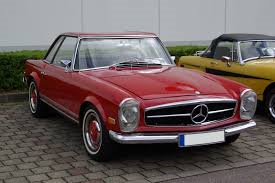-
Insurance
InsuranceAbout our productsLearn about insuringGet a quote Get current values, historical values, model history and more.
-
Valuation
ValuationHagerty valuation toolLook up a vehicle value Get current values, historical values, model history and more.
-
Events
EventsHagerty official eventsHagerty ClubhouseEvent calendar
-
Entertainment
EntertainmentMore to explore
- Portal login
1967 Mercedes-Benz 250SL
W113 Convertible 2.5 L
Vehicle values by condition
Fair
Condition 4
£41,200
#4 cars are daily drivers, with flaws visible to the naked eye. The chrome might have pitting or scratches, the windshield might be chipped.
Good
Condition 3
£62,100
#3 cars could possess some, but not all of the issues of a #4 car, but they will be balanced by other factors such as a fresh paint job or a new, correct interior.
Excellent
Condition 2
£114,000
#2 cars could win a local or regional show. They can be former #1 cars that have been driven or have aged. Seasoned observers will have to look closely for flaws.
Concours
Condition 1
£171,000
#1 vehicles are the best in the world. The visual image is of the best car, unmodified, in the right colours, driving onto the lawn at the finest concours.
Insurance premium for a
1967 Mercedes-Benz 250SL W113 Convertible 2496
valued at £62,100
£314.74
/ year*
History of the 1966 - 1968 Mercedes-Benz 250SL

1966 - 1968 Mercedes-Benz 250SL
Mercedes-Benz W113 SL (Convertible), 1963-1971
The Mercedes-Benz W113 SL was in production from 1963 to 1971. Styled in house by Paul Bracq and Bela Barenyi, it is a front-engine, rear wheel drive sports car seating two adults.
Launched in 1963 as the 230SL, the W113 - colloquially known as the Pagoda SL - was intended as a replacement for the 190SL sports car. It offered higher performance, and technically had its roots in a development of the 190 termed the 220SL, with six cylinders. Delays meant that the 220SL looked outdated before it was launched, so a new design was mooted based around a shortened version of he W111 Fintail floorpan. That car became the fuel injected 230SL. Mercedes-Benz updated the model over the years - increasing the stroke to create the 250SL of 1967, and increasing the bore the following year to create the 280SL. Replaced by the new, heavier, W114-based R107SL in 1971, many regard the W113 as the finest of all Mercedes-Benz SLs and it is one of the most desirable as a result.
Front wings, pillars, sills and rear chassis rails are known rust spots, as well as both valances and the boot floor. Distributors and throttle bodies can fail, while 230s in particular can pink as a result of uncontrolled detonation. Tappets and oil leaks can also be trouble spots. Fortunately, most panels and trim are available through specialists, meaning that a W113 can be effectively restored if your pockets are deep enough. Rear axle gaiters can leak - it's a full strip down to replace. Make sure the steering box is neither too loose, nor so tight that overtightening has caused internal damage.
For looking the part in the 1960s nothing else this side of an E-type carried the same cachet as the SL - and this and the Aston Martin DB4 are arguably the closest rivals to the Mercedes-Benz. Today though, you might also consider a Jensen Interceptor, or if you find the W113 a little to expensive, a good early R107 will offer the same Mercedes-Benz SL experience for a far lower price.
Hagerty Newsletter
Get your weekly dose of car news from Hagerty UK in your inbox

ADVERTISEMENT